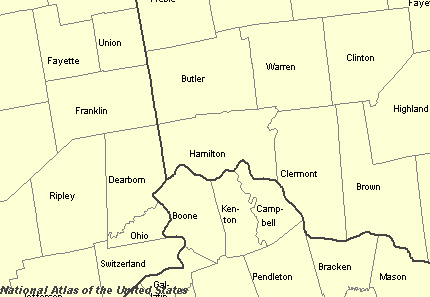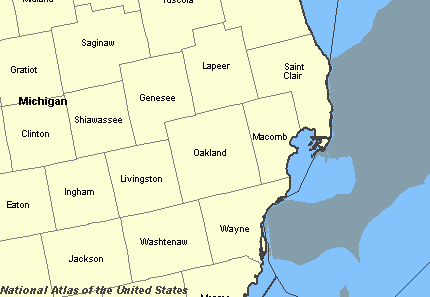| This article first appeared in the September 2002 issue of Monitoring Times. |
As the summer months fade into autumn we take a look at several new trunked radio systems that will be built over the next few years. Many of these systems will follow the APCO (Association of Public Safety Communications Officials International) Project 25 standard, while one county has decided to take a different route.
Cincinnati, Ohio
The city of Cincinnati, in southwest Ohio, has contracted with Motorola for a $23 million, 20-channel APCO Project 25 digital radio system. The city's current dispatch center at police headquarters will be upgraded, along with a backup site currently under construction. Nearly 2,000 digital-capable radios will be purchased under the contract. City planners expect the system will come online in about two years, first with police, fire and emergency medical services and later with other government departments.
Installing a system with complete coverage for the 78-square-mile city will be a challenge, since Cincinnati is situated in a river valley with numerous high hills. The contract lists ten repeater sites connected to the dispatch center via digital microwave links, plus 15 towers in Hamilton County. Part of the plan is to integrate the new city radios with an existing county system.
 Hamilton County, Ohio
Hamilton County, Ohio
Cincinnati is located in Hamilton County, which is currently running dispatch operations in the 460 MHz band. For radio purposes the county has been divided into three sectors: East, Central and West. East Sector starts at the Clermont County line and runs west to U.S. Route 42. From there to U.S. Route 127 is Central Sector, and from U.S. Route 127 to the Indiana State Line is West Sector.
Current dispatch frequencies are:
| East Sector | 460.025 MHz |
| Central Sector | 460.400 MHz |
| West Sector | 460.175 MHz |
For the past three years the county has also been building an 800 MHz Motorola Type II system, which is behind schedule and not yet fully operational. The system is expected to run in both analog and digital modes until county law enforcement agencies join the system, at which point it should switch to full digital operation. County fire and emergency medical services already have their Astro radios installed but continue to simulcast on VHF lowband at 33.900 MHz.
Frequencies for the Hamilton County trunked radio system are 866.1625, 866.2500, 866.2750, 866.3000, 866.5375, 866.6500, 866.7875, 867.2375, 867.5375, 867.7375, 867.7625, 867.8125, 867.8500, 867.9500, 868.1250, 868.1500, 868.2625, 868.3625, 868.5625 and 868.9500 MHz.
There are also reports that the city of Cincinnati is operating a Motorola Type II radio system for the Vice Division of the Police Department. The following frequencies are listed: 866.1875, 866.2125, 866.4625, 866.5625, 866.6875, 866.8125, 866.8375, 867.0875, 867.1125, 867.3125, 867.3375, 867.6125, 867.6375, 866.5875 and 868.8625 MHz. Apparently only a couple of talkgroups are active, primarily related to surveillance.
Interestingly, the Greater Cincinnati Northern Kentucky International Airport is operating a seven-channel analog EDACS system on 856.7375, 856.9375, 857.7375, 857.9375, 858.9375, 859.7375 and 860.7375 MHz. This will make for another interoperability challenge should there be a major incident in or around the airport. The Airport Police are reportedly using talkgroup 02-022 and the Fire/Rescue crews use 02-041.
Also at the airport is a Motorola Type II system operated by Delta Airlines. Frequencies listed are 938.2000, 938.6500, 938.7000, 938.7500, 939.1500 939.2500, 939.6500, 939.7000, 939.7125 and 939.7500 MHz, with talkgroups 40960 and 41008 in use for Gate Control and numerous talkgroups for Baggage Handling.
 Nassau County, New York
Nassau County, New York
The Nassau County, New York, Police Department has received approval from the Federal Communications Commission (FCC) to build a new radio system using frequencies between 500 MHz and 506 MHz, which is normally used by television channel 19. Nassau County, covering nearly 300 square miles, is located on Long Island, just to the east of New York City.
Although the initial television channel allocations were done in 1952, since 1970 the FCC has allowed television channels 14 through 20 to be used for land mobile service in large urban areas. Channel 19 is assigned to the Philadelphia, Pennsylvania area, but was basically unused on Long Island. Nassau County needed a waiver, since under FCC rules the base stations for such service must be within 50 miles of the center of the assigned city. The four base stations proposed by Nassau County are all between 90 and 110 miles away from Philadelphia. The FCC had granted similar waivers in the past, including waivers for various transmitters in northern New Jersey to operate on TV channel 19 frequencies. Nassau County made a successful showing that, among other things, there were no available frequencies in VHF, UHF, or 800 MHz that could be used and that the proposed system would not cause interference to currently licensed operations.
The proposed system will consist of 30 trunked voice channels, each 12.5 kHz wide, plus five conventional (non-trunked) channels for tactical use and 12 channels for mobile data applications. The system is designed to support more than 5,000 radios broken down like this:
| Nassau County Police Department | 2,200 |
| Sheriff's Department | 1,300 |
| Volunteer Fire Departments | 1,200 |
| City/Village Departments | 800 |
| Emergency Medical Services | 120 |
| District Attorney's Office | 100 |
| Other Services | 150 |
The current Nassau County Police Department radio system operates on eleven channels in the 477 - 481 MHz band (TV channel 15), which they intend to relinquish after transitioning to the new system. They currently employ more than 2,800 officers and use about 2,000 radios (500 mobile and 1,500 portable units).
Nassau County itself currently operates an EDACS system on the following frequencies: 866.1875, 866.3375, 866.5875, 866.7375, 866.8375, 866.9000, 867.1125, 867.1750, 867.9000, 868.1750 (control channel), 868.4250, 868.5750, 868.7250 and 868.6500 MHz. The system is shared by a number of county and local agencies.
 Oakland County, Michigan
Oakland County, Michigan
Oakland County, Michigan, located northwest of downtown Detroit, contracted with M/A-COM for a $33 million radio system based on the OpenSky network. OpenSky is a fully digital system that uses Internet Protocol (IP) to carry voice and data traffic. Each radio frequency is divided into timeslots, allowing as many as four conversations to occur simultaneously in each channel. The State of Pennsylvania is currently installing a statewide OpenSky system, although progress reports from that effort are few and far between. M/A-COM expects Oakland County's system to be up and operating by the end of 2004, linking more than 80 agencies across the 900-square-mile county.
M/A-COM makes the claim that their OpenSky network can interoperate with other analog and digital radio systems. This will be interesting to see, since the State of Michigan is in the final phase of their APCO Project 25 system installation, having spent eight years and well over $100 million to provide statewide coverage.
 Uniden Digital Scanner features
Uniden Digital Scanner features
Uniden has released additional information regarding their APCO Project 25 scanners, due for release in November. Both scanners, the handheld BC250D and the base/mobile BC785D, are expected to have continuous coverage from 25 MHz to 1.3 GHz, less the 800 MHz cellular telephone band. They will each have 1100 channels in 10 banks and the ability to program the delay, step size, priority, attenuation, and other settings on a per-channel basis. A nine-pin serial data connector will allow the user to program and control the radio from an external computer.
 Each radio will be equipped with what Uniden calls "Trunktracker III",
meaning it can natively track Motorola, EDACS and LTR systems. With the
addition of a BCi 25D APCO 25 Digital Card, either radio will be able to
track and decode digital transmissions from APCO Project 25 systems.
Each radio will be equipped with what Uniden calls "Trunktracker III",
meaning it can natively track Motorola, EDACS and LTR systems. With the
addition of a BCi 25D APCO 25 Digital Card, either radio will be able to
track and decode digital transmissions from APCO Project 25 systems.
The radios will also provide CTCSS/DCS decoding along with S.A.M.E. (Specific Area Message Encoding) weather alerts and pre-programmed service searches. Uniden is promising that the radios will be capable of scanning near 100 channels or steps per second.
BC780XLT Squelch Modification
Hi Dan,Somewhere recently I read an article that gave some tips on how to adjust the squelch threshold internally on the BC 780 XLT so as to even the spread between the squelch breaking point on VHF and UHF.
As you probably know these radios cause you to have to tighten the squelch on UHF more than is necessary on VHF, thus becoming a nuisance when trying to scan both frequencies. The VHF is too tight and/or the UHF is too loose. Internally there is an adjustment that can be made by someone with a smattering of sense, and that is the information I am seeking.
Any help you can give would be appreciated.
John in South Carolina
The mismatch in squelch breakpoint between VHF and UHF on the Bearcat 780XLT radio is a common problem on early production models. I have heard that this problem has been fixed, or at least greatly reduced, on later models.
Internally, the radio has a number of internal potentiometer settings:
RT-1 S-meter Narrow FM/FM
RT-2 Squelch Wide FM
RT-3 Squelch Narrow FM
RT-4 S-meter Wide FM
RT-5 Tone decode frequency for the weather alert
RT-6 Frequency for reference oscillator for Phase Lock Loop and 3rd mixer
RT-7 Squelch FM
RT-8 Tune voltage for the 108-137 MHz filter
RT-9 Tune voltage for the 137-174 MHz filter
The idea for the squelch modification is to adjust RT-3 (Narrow FM squelch threshold) until the minimum squelch (the "breakpoint") is the same in both VHF and UHF. I do not own a 780XLT so I have not tried this modification personally. I would not recommend this or any other hardware modification for anyone who is not familiar with electronics. As always, any modifications are done at your own risk, so if your radio doesn't work after trying this, it's not our fault!
Anyway, here is the procedure:
Part A: Setup the radio
1. Select a UHF frequency such as 445.0000 MHz.
2. Set up a channel at the UHF frequency in regular FM mode.
3. Set up a second channel at the same UHF frequency, but in Narrow FM mode.
Part B: Check the current settings
1. Select the regular FM channel.
2. Adjust the squelch knob to the minimum (breakpoint) setting.
3. Switch to the narrow FM channel.
4. Check the squelch setting.
5. If the settings are the same, no adjustments are necessary.
6. If the settings are different, perform the steps in part C.
Part C: Adjust the Narrow FM setting
1. Remove the back cover
2. Identify RT-3 (Narrow FM squelch adjustment)
3. Select the regular FM channel.
4. Adjust the squelch knob to the minimum (breakpoint) setting.
5. Switch to the narrow FM channel.
6. Carefully adjust RT-3 until the squelch just cuts in (the exact point where radio goes quiet)
7. Switch between the two channels to confirm that the setting is correct.
That's all for this month. I welcome your questions and comments via e-mail at dan@signalharbor.com, and I've got more information and links on my website at www.signalharbor.com. Until next month, happy monitoring!